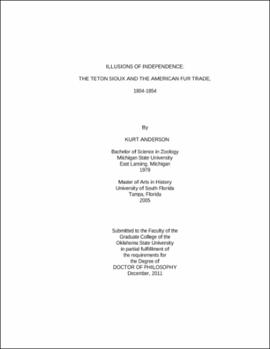| dc.contributor.advisor | Moses, L. G. | |
| dc.contributor.author | Anderson, Kurt Clay | |
| dc.date.accessioned | 2013-11-26T08:24:12Z | |
| dc.date.available | 2013-11-26T08:24:12Z | |
| dc.date.issued | 2011-12 | |
| dc.identifier.uri | https://hdl.handle.net/11244/6775 | |
| dc.description.abstract | Scope and Method of Study: | |
| dc.description.abstract | This study examines the relationship between the Teton Sioux and the American fur trade during the years from 1804-1854, specifically, both its contribution to their conquest of the north-central plains and to what degree that trade involved the Sioux in a global, consumer economy. This study draws freely from the following primary sources: transcribed Indian winter counts and oral histories, journals and diaries of trappers, traders, and white emigrants, government documents, and period newspapers. Secondary sources include an abundance of material from the following disciplines: history, ethnohistory, historical geography, anthropology, archaeology, political economy, economic history, gender studies, foreign relations, public history, and material culture. | |
| dc.description.abstract | Findings and Conclusions: | |
| dc.description.abstract | The nineteenth-century history of the Teton Sioux is indeed a study of contradictions. While their attitude toward the members of the Corps of Discovery prompted William Clark to call them the "vilest miscreants of the savage race," Manuel Lisa found them to be firm allies of the United States during the War of 1812, and, in 1823, they fought alongside Colonel Henry Leavenworth's Missouri Legion against the Arikaras. But, it was the establishment of Fort Laramie in 1834 that subsequently tied the Western Sioux to the Americans in a symbiotic trade relationship that secured the peace between them for the next twenty years. It was, however, the Tetons wholesale submersion in the buffalo robe and hide trade in the two decades after 1834 that also tied them irrevocably to Euro-American consumerism and eventually compromised their ability to maintain their political and economic independence. By the time of the Fort Laramie Peace Conference of 1851, the Tetons' military, political, and economic power had reached its zenith. Then, an incident in the summer of 1854 between the United States army and bands of Sioux camped along the Oregon Trail adjacent to Fort Laramie brought the Tetons into direct conflict with the Americans. The aftermath of that incident exposed the degree to which the Western Sioux had become dependent upon Euro-American trade goods. By 1854, the Tetons' dependence on those goods was complete. | |
| dc.format | application/pdf | |
| dc.language | en_US | |
| dc.rights | Copyright is held by the author who has granted the Oklahoma State University Library the non-exclusive right to share this material in its institutional repository. Contact Digital Library Services at lib-dls@okstate.edu or 405-744-9161 for the permission policy on the use, reproduction or distribution of this material. | |
| dc.title | Illusions of independence: The Teton Sioux and the American fur trade, 1804-1854 | |
| dc.contributor.committeeMember | Rohrs, Richard C. | |
| dc.contributor.committeeMember | Smith, Michael Myrle | |
| dc.contributor.committeeMember | Bays, Brad Alan | |
| osu.filename | Anderson_okstate_0664D_11839.pdf | |
| osu.accesstype | Open Access | |
| dc.type.genre | Dissertation | |
| dc.type.material | Text | |
| dc.subject.keywords | american fur trade | |
| dc.subject.keywords | teton sioux | |
| thesis.degree.discipline | History | |
| thesis.degree.grantor | Oklahoma State University | |
